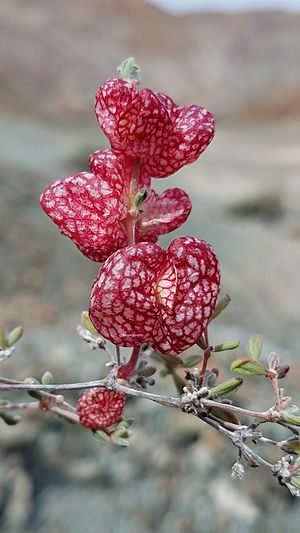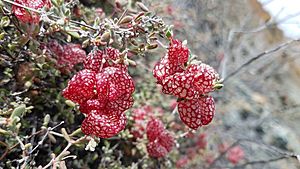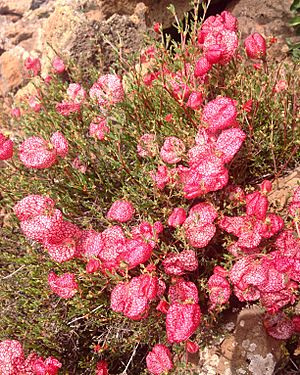Rabbit's purse facts for kids
Quick facts for kids Rabbit's purse |
|
|---|---|
 |
|
| Scientific classification | |
| Genus: |
Harfordia (plant)
|
| Species: |
macroptera
|
The Harfordia macroptera is a special plant known as the rabbit's purse. It is a woody plant that lives for many years, called a perennial. This plant belongs to the Polygonaceae family.
The rabbit's purse is the only type of plant in its group, called the Harfordia genus. It grows only in the Baja California Peninsula in Mexico. This plant is easy to spot because of its unique, balloon-like structure. This structure has red to purple lines and surrounds the plant's fruit. It's actually a changed bract, which is like a small leaf. This special bract helps the plant's seeds fly away in the wind.
Contents
What the Rabbit's Purse Looks Like
This plant grows as a shrub or subshrub, which means it's a woody plant that spreads out. Its most noticeable feature is the colorful, sac-like bracts. These bracts help the plant spread its seeds, called achenes.
Some rabbit's purse plants have both male and female parts on the same plant (monoecious). But most often, male and female parts are on separate plants (dioecious). You might not notice these plants in nature until their balloon-like bracts are fully grown.
Plant Parts and Structure
The rabbit's purse has many thin or thick stems. These stems grow from a woody taproot, which is a main root that grows straight down. The leaves grow in pairs along the stem. They can be shaped like a narrow line, a spoon, or an oval.
The leaves can be smooth or covered with tiny, slightly curled hairs. They are usually thin but can also be a bit thick and succulent, meaning they store water.
The plant's flowers grow in groups in the leaf corners. On plants with both male and female flowers, or only female flowers, they grow on short, thick stalks called peduncles. These stalks are usually covered in tiny hairs. Male plants do not have the special sac-like bracts. On other plants, this bract is very changed. It forms a sac or bladder that grows bigger as the flower develops. This sac is clear and has deep red to red-purple veins. It does not have hairs.
The flowers can have both male and female parts, or just one type. They have 6 petal-like parts called tepals, all shaped like a spear. Male flowers are light yellow and smaller. They sometimes have a part that would be an ovary but it doesn't develop. Female flowers start light yellow but turn red or rose. They always have parts that would be stamens but they don't develop. Flowers with both parts are light yellow to rose.
There are 9 stamens. In male flowers, these stick out a bit on long threads and have yellow oval parts that hold pollen. In female flowers, these threads are tiny and the pollen parts are small and don't work.
The plant's fruit is an achene, which is a small, dry fruit with one seed. It is about 3 to 5 millimeters long and is yellowish-brown to brown.
How Rabbit's Purse Was Named
Plant Classification
When these plants were first found, scientists thought they belonged to a different group called Pterostegia. But then they realized that the rabbit's purse was a woody perennial, unlike the other Pterostegia plants which only lived for one year. Also, its large, balloon-like bracts were very special.
Because of these differences, two scientists, Edward Lee Greene and Charles C. Parry, created a new group called Harfordia. They placed the rabbit's purse, Harfordia macroptera, into this new group. They also included two other similar plants: Harfordia galioides and Harfordia fruticosa.
Later, another scientist named Ira Loren Wiggins only included H. macroptera in his plant guide for the Sonoran Desert. He thought Pterostegia galioides was the same plant and didn't include H. fruticosa because it only grew on Cedros Island.
Then, James L. Reveal looked at all three plants Greene had described. He decided they were all types of the same plant, Harfordia macroptera. He called them different "varieties" of this one plant. He made this decision because these varieties mostly grew in different places. They only grew together in one small area in northwestern Baja California Sur. Where they overlapped, plants with mixed features were found.
Different Types of Rabbit's Purse
Even though the three types of rabbit's purse look only a little different, they grow in separate areas. Here are the three varieties:
- Harfordia macroptera var. galioides (Vizcaino rabbit's purse) – This is a large shrub that often spreads out. It grows 30 to 60 centimeters tall and 40 to 80 centimeters wide. Its leaves are narrow and can be 0.8 to 2 centimeters long and 0.5 to 2 millimeters wide. They are hairy with slightly curled hairs. The sac-like bract is 2 to 3 centimeters wide when fully grown. This type is found from San Vicente in northwestern Baja California to the Vizcaino Peninsula.
- Harfordia macroptera var. fruticosa (Cedros rabbit's purse) – This is a large spreading shrub that is 10 to 30 centimeters tall and 20 to 40 centimeters wide. Its leaves are wider, shaped like a spoon or oval. They are 0.2 to 0.8 centimeters long and 2 to 4 millimeters wide. They are smooth and thick, like succulent plants. The sac-like bract is 1 to 2 centimeters wide when fully grown. This type grows only on Cedros Island, off the coast of Baja California.
- Harfordia macroptera var. macroptera (Magdalena rabbit's purse) – This is a large spreading shrub that is 20 to 40 centimeters tall and 40 to 60 centimeters wide. Its leaves are wide, shaped like a spoon or oval. They are 0.5 to 1.5 centimeters long and 2 to 6 millimeters wide. They are smooth and thick, like succulent plants. The sac-like bract is 1 to 2 centimeters wide when fully grown. This type is common in gravelly soil around the Magdalena Bay area and nearby islands in Baja California Sur.
Life Cycle and Seed Dispersal
The special bladder or sac-like structure that surrounds the plant's seed (the achene) starts as a tiny, young bract. This bract is initially bent back and made of three parts that only connect where they attach to the flower stalk (pedicel).
As the bract grows, it gets bigger and forms a cover around the flower stalk. Once the flower inside is fertilized, the bract quickly expands upward and outward. Eventually, the whole structure completely covers the seed. The two flat sides of the bract keep growing to form the noticeable bladder-like part.
Scientists believe this changed bract helps the seed spread. The inflated, papery bract is easily detached and blown by the wind, carrying the seed inside. This allows the fully grown seed to be easily moved to new places. The bract does dry out, but because it has many veins, it doesn't just fall apart. Even after it detaches, rain can make it inflate again, and winds from thunderstorms can help it move. The seed can stay with these bracts for up to two or three years.
See also
 In Spanish: Harfordia macroptera para niños
In Spanish: Harfordia macroptera para niños



